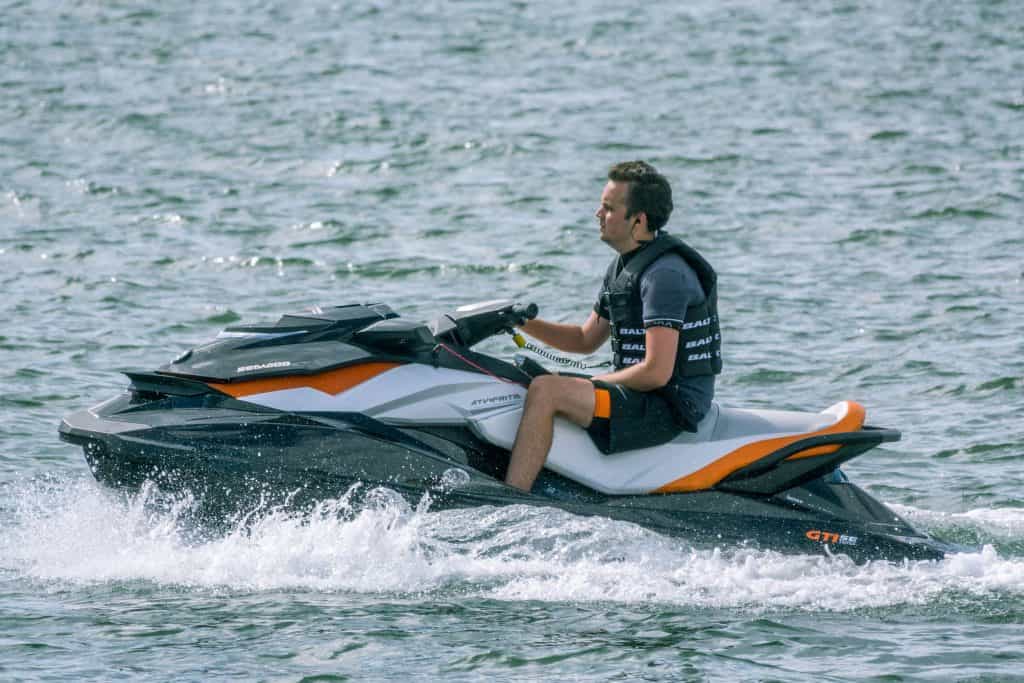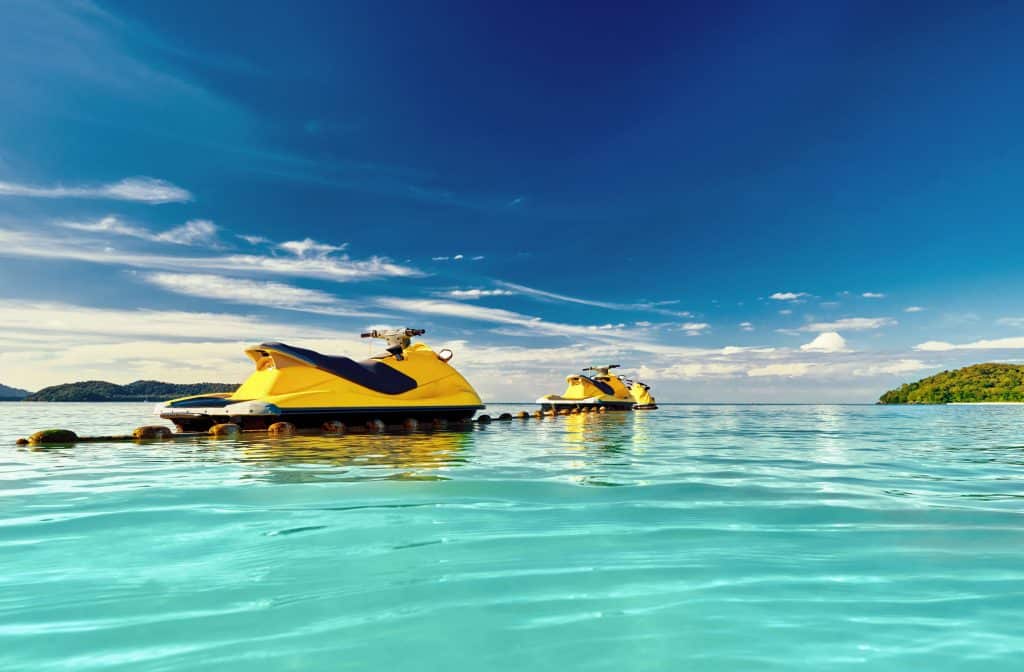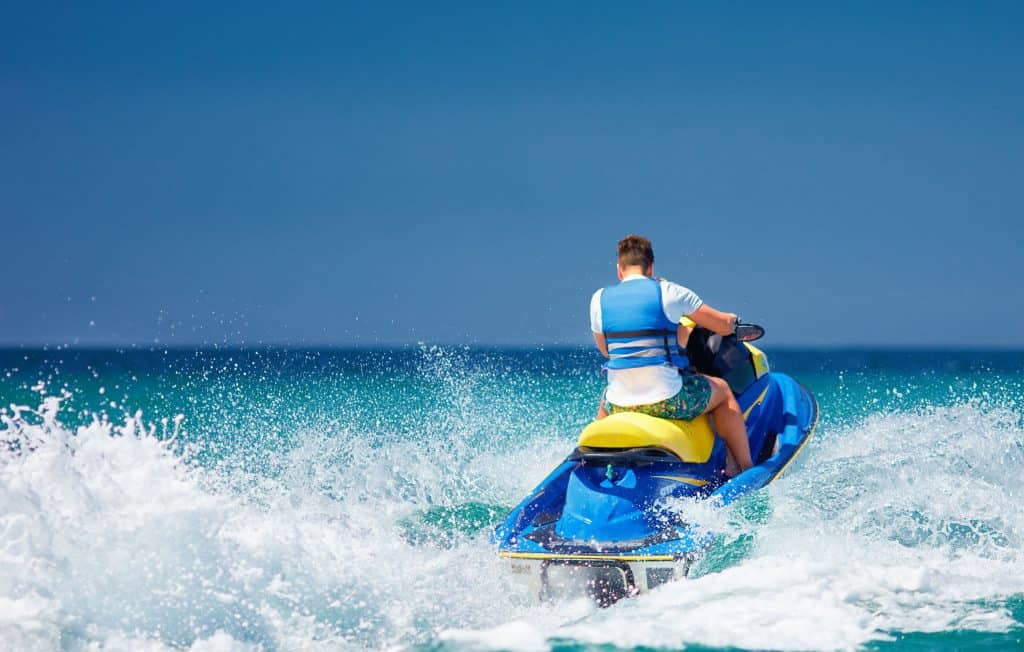Jet skiing in the summertime is a great way to have fun with family and friends. In order to have a great time, you will need to know the laws for riding a jet ski according to the state you reside in. Rules and regulations can vary between states. It is a need-to-know in order to be able to enjoy your time on the water safely.
In the state of Missouri in order to operate a personal watercraft vehicle, you need to be at least 14 years of age or older than that. You must also be accompanied by a person who is 16 years old or older. All operators born after January 1, 1984, must complete a Boating Safety Certification course and receive a card.
It is important to be aware of the following regulations and laws for riding a jet ski on the water within the state of Missouri. By doing so you are following the law responsibly.

Basics to Registering Your PWC in Missouri
Missouri Registration Fees
| WATERCRAFT REGISTRATION | |
| Class A Vessel | $25.00 |
| Class 1 Vessel | $55.00 |
| Class 2 Vessel | $100.00 |
| Class 3 Vessel | $150.00 |
| Registration Processing Fee | $3.50 |
| WATERCRAFT TITLING | |
| New Vessel Title | $7.50 |
| Transfer Vessel Title | $7.50 |
| Transfer Motor Title | $5.00 |
| Duplicate Vessel Title | $8.50 |
| Duplicate Motor Title | $5.00 |
| Title Processing Fee | $2.50 |
| OUTBOARD MOTOR REGISTRATION & TITLING | |
| New Outboard Motor Title | $5.00 |
| Outboard Motor Registration | $2.00 |
Numbers and Stickers
Once you receive your registration number and the validation stickers that come with it you should display these items in the following ways:
- There cannot be any other numbers shown on the bow of your vessel.
- The letters have to separate from the numbers with a hyphen or space.
- The color of your numbers must also be in contrast to the color of your vessel.
- Each number must be in block letters and three inches high.
- The numbers must be read from left to right on both sides.
- Each number should be painted, applied onto your vessel as a decal, or place to be shown on both sides of the bow.
Hull Identification Number
A Hull Identification Number (HIN) is a 12-digit number that is assigned by the manufacturer to the vessel built after the year 1972. HIN helps be able to determine the difference between other vessels and identify the owner as well.
In case your vessel is stolen you should write down your HIN and place it somewhere safe and secure.

The Basics to Operating a PWC
Reckless Operation of a PWC
Improper Speed or Distance
Failing to go at a reasonable speed and even going faster than the speed recommended, especially during vessel traffic, poor weather conditions and closeness to shore can result in injuries.
To be more specific, here are some actions that are considered to be illegal in the state of Missouri:
- Going at a speed that can be harmful to your vessel.
- going faster than the speed limit posted near the body of water you are operating on.
- Being within 20 feet of the outer boundary area that is marked by signs and buoys of it being a restricted area.
- Operating at a greater speed than “slow, no wake” speed that is posted in a “no wake” zone.
- Operating your vessel at extreme speeds in the close vicinity of another vessel, PWCs or dangerous waters.
- Roaming around a swimming area (within 20 feet) and it is marked with red and yellow buoys.
- Operating your PWC within 20 feet of another person who is fishing (without gaining their permission first).
Overloading and Overpowering
Going against the recommended weight and horsepower shown on your PWC or vessel is unsafe. You should never exceed the maximum number of persons or weight that is recommended when you purchase or operate a PWC.
If the PWC does not have a plate, in which it shows its capacity, the owner must be able to demonstrate that the PWC follows the safe loading and powering requirements given by the U.S. Coast Guard.
Hazardous Condition
This is when you knowingly allow another person to use a PWC or vessel when they suffer from any conditions that may prevent them from operating the vessel accurately. Conditions that can be a hazard to the operator and their passengers are:
- If the operator has a physical or mental disability.
- If there are not enough personal flotation devices, fire extinguishers, backfire flame arrestors, or navigational lights.
- Or if an unsafe condition simply exists.
Reckless Operation
Recklessly operating and being negligent of the rules for operating a vessel or PWC is putting yourself and others in danger. The following are examples of negligent and reckless operation of a PWC or vessel:
- anyone who is swimming nearby
- any other PWC or vessel
- anyone who is on a PWC or vessel that is fishing, water skiing, or engaging in water activity
- unsafely approaching or passing a dock, ramp, a moored or anchored or even a swimming area that is marked is illegal
Boating While Under the Influence
In the state of Missouri, you are considered to boat while under the influence of drugs and/or alcohol if your blood alcohol concentration is 0.08%. (The state had lowered it from its previous percentage of 0.10%.
The following penalties are inforced if you are convicted of boating under the influence:
- Upon your first conviction are you will be guilty of a Class B misdemeanor and you will be required to complete and pass a boating safety course.
- Upon your second conviction, you will be guilty of a Class A misdemeanor.
- Upon a third conviction, you will be guilty of a Class E felony.

Required Equipment in Missouri
Personal Flotation Devices
| Type 1 | Offshore Life Jackets | This vest can turn an unconscious person in the water to face up in the water. It was made for rough waters and for situations where rescue might take a long time. |
| Type 2 | Near-Shore Vests | This vest is fit for calmer waters and faster rescues. If you were to wear this while unconscious it may not be able to turn your face up in the water. |
| Type 3 | Flotation Aids | This vest can also be a full-sleeved jacket and it is great for calm waters and fast rescues. This will definitely not turn your face up in rough waters. This is generally worn for water sports. |
| Type 4 | Throw able Devices | This type of flotation device is a cushion or ring buoys and are typically used to throw at someone in trouble. They are not made to last for long hours in the waters, or non-swimmers, or the unconscious. |
| Type 5 | Special-Use Devices | This type of flotation device was made for activities like kayaking, water-skiing These typically look like white water vests, deck suits, and personal flotation device hybrids. |
Requirements for PFD
These fire extinguishers must stay in a usable condition. You need to regularly check up on the extinguishers to ensure they are in the best condition:
- There is no physical damage, corrosion, leakage, or clogged nozzle.
- Pressure gauges or indicators read in the operable range.
- Seals and tamper indicators are not broken or missing.
Fire Extinguishers
You can classify your fire extinguishers by letter and number symbol. The number helps you decipher the size of the extinguishers, and the letter indicates the type of fire that extinguisher can be used for as well.
| Type A Fires | These types of fires are combustible solids such as wood |
| Type B Fires | These types of fires are flammable liquids like gasoline or oil |
| Type C Fires | This type of fire is mainly electrical fires |
These fire extinguishers must stay in a usable condition. You need to regularly check up on the extinguishers to ensure they are in the best condition:
- There is no physical damage, corrosion, leakage, or clogged nozzle.
- Pressure gauges or indicators read in the operable range.
- Seals and tamper indicators are not broken or missing.
What To Do in a PWC Accident
In the event of an accident you must:
- Stop the vessel or PWC you are on immediately.
- Assist those who are injured or in danger, unless it puts you or others in danger.
- You will need to give, in writing, the name of the person who was injured, their address, and the vessel identification to the person injured and the owner of the property that was damaged.
